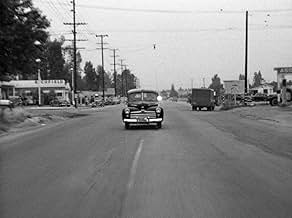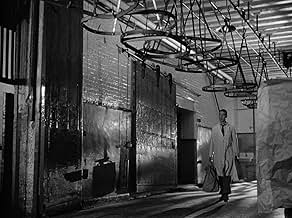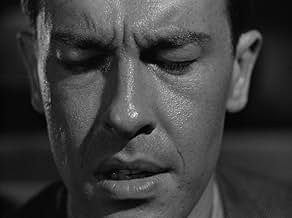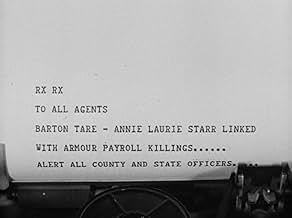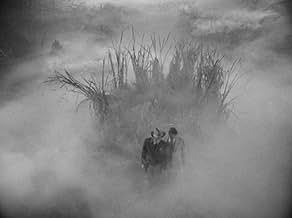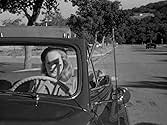IMDb-BEWERTUNG
7,6/10
16.033
IHRE BEWERTUNG
Füge eine Handlung in deiner Sprache hinzuTwo disturbed young people release their fascination with guns through a crime spree.Two disturbed young people release their fascination with guns through a crime spree.Two disturbed young people release their fascination with guns through a crime spree.
- Auszeichnungen
- 1 wins total
Russ Tamblyn
- Bart Tare (age 14)
- (as Rusty Tamblyn)
David Bair
- Dave Allister (child)
- (as Dave Bair)
Frances Irvin
- Danceland Singer
- (as Frances Irwin)
Empfohlene Bewertungen
The original title of "Gun Crazy" was "Deadly Is the Female," and they ain't kidding. If you thought Faye Dunaway's Bonnie Parker was the more ruthless member of the crime duo that gave Arthur Penn's 1967 film its name, wait till you get a load of Peggy Cummins's Annie in this little known cheapie from 1949. I wouldn't want to get on this woman's bad side; she can shoot cigarettes out of people's mouths, for God's sake.
"Gun Crazy" is such an obvious influence on Penn's "Bonnie and Clyde" that I can't believe the later film doesn't credit it directly. Though the 1949 film is based on a short story that appeared in the "Saturday Evening Post" and the 1967 film worked with an original screenplay, both films could have been adapted from the same source. They portray the Annie/Bonnie character as bored and restless, turned on by the thought of crime and by a manly man who can really use his "gun." The Bart/Clyde character is tickled by the idea of being a virile stud in the eyes of his lover, but is ultimately too sensitive for the life they choose. And both films do a good job of portraying the desperation that plagues both couples, the isolation and loneliness they create for themselves and can never break out of, and the ultimate futility of their actions, since the "law" is going to catch up with them sooner or later.
Peggy Cummins is really good in this. I don't know what else she's been in, but her baby-doll voice creates an effective contrast to her colder-than-ice attitude. She's crooning into her lover's ear one minute and itching to kill someone the next. And you have to dig those French-inspired fashions that would cause a sensation nearly 20 years later when Dunaway donned them again for Penn's film.
I thought John Dall was at first odd casting for the role of Bart. Annie is supposed to think of him as a man's man, and Dall, with his willowy physique and gentle mannerisms is far from that. But then when we realize that he's at heart really too gentle for the life he and Annie have chosen for themselves, his casting makes sense.
There are some small touches to this film that really add to its immediacy and realism. I loved the scenes of Annie and Bart driving to and from their heist jobs, shot from the back seat of the car as if we are a member of their gang. They have really funny and natural banter back and forth about where to park, etc. which I have to believe was improvised to some extent. The ending of the film, a face off in a creepy swamp, is eerie, and there's a small twist in the last seconds of the film that might be easy to miss but may give you some things to think about if you catch it.
It's interesting, and rather depressing, that one of the main themes of this film is the obsession with guns and violence that pervaded the country nearly 60 years ago, and here we are a handful of wars later, still dragging around the same old obsessions. Michael Moore's recent documentary "Bowling for Columbine" could have just as easily been called "Gun Crazy," if that title weren't already taken by this forgotten little blast of a movie.
Grade: A-
"Gun Crazy" is such an obvious influence on Penn's "Bonnie and Clyde" that I can't believe the later film doesn't credit it directly. Though the 1949 film is based on a short story that appeared in the "Saturday Evening Post" and the 1967 film worked with an original screenplay, both films could have been adapted from the same source. They portray the Annie/Bonnie character as bored and restless, turned on by the thought of crime and by a manly man who can really use his "gun." The Bart/Clyde character is tickled by the idea of being a virile stud in the eyes of his lover, but is ultimately too sensitive for the life they choose. And both films do a good job of portraying the desperation that plagues both couples, the isolation and loneliness they create for themselves and can never break out of, and the ultimate futility of their actions, since the "law" is going to catch up with them sooner or later.
Peggy Cummins is really good in this. I don't know what else she's been in, but her baby-doll voice creates an effective contrast to her colder-than-ice attitude. She's crooning into her lover's ear one minute and itching to kill someone the next. And you have to dig those French-inspired fashions that would cause a sensation nearly 20 years later when Dunaway donned them again for Penn's film.
I thought John Dall was at first odd casting for the role of Bart. Annie is supposed to think of him as a man's man, and Dall, with his willowy physique and gentle mannerisms is far from that. But then when we realize that he's at heart really too gentle for the life he and Annie have chosen for themselves, his casting makes sense.
There are some small touches to this film that really add to its immediacy and realism. I loved the scenes of Annie and Bart driving to and from their heist jobs, shot from the back seat of the car as if we are a member of their gang. They have really funny and natural banter back and forth about where to park, etc. which I have to believe was improvised to some extent. The ending of the film, a face off in a creepy swamp, is eerie, and there's a small twist in the last seconds of the film that might be easy to miss but may give you some things to think about if you catch it.
It's interesting, and rather depressing, that one of the main themes of this film is the obsession with guns and violence that pervaded the country nearly 60 years ago, and here we are a handful of wars later, still dragging around the same old obsessions. Michael Moore's recent documentary "Bowling for Columbine" could have just as easily been called "Gun Crazy," if that title weren't already taken by this forgotten little blast of a movie.
Grade: A-
Bart Tare (John Dall) had a fascination with guns from an early age, even getting sent to a reform school at the age of 14 for yet another gun related incident. Back home now as an adult, after a stint in the army, he falls for a sharp-shooting carnival girl called Annie Laurie Starr (Peggy Cummins) and promptly joins the act. But after a fall out with the boss, the pair hit the road and turn to a life of crime - with Annie particularly showing a thirst for gun-play.
No doubt inspired by real life outlaws Bonnie Parker and Clyde Barrow, "Deadly Is the Female" (AKA: Gun Crazy) is as good a "doomed lovers on the lam" picture that has ever been made. It may be a "B" movie in terms of production, but no doubt about it, this film is stylish, crafty and also very sexy. Directed by the unsung Joseph H. Lewis ("My Name Is Julia Ross/The Big Combo"), it's based on a story written by MacKinlay Kantor that was reworked by Millard Kaufman (AKA: the then blacklisted "Dalton Trumbo"), into one that links sex and violence whilst simultaneously casting an eye over gun worship and its place in the American way of life. Dall & Cummings looked on the surface an odd pairing, but under Lewis' direction they go together like gun and holster (ahem). He is well spoken, almost elegantly fragile with his musings, yet underneath there is still this twitchy gun fanatic. She is savvy, almost virginal in sexuality, but ultimately she's a wild cat who's practically un-tamable.
The work of Lewis here should not be understated, check out the quite sublime continuous one take bank robbery. While marvel throughout at his long takes, use of angles, deep focus and jerking camera movements - all of which dovetail with our protagonists as they go on their nihilistic journey. But perhaps his master-stoke was with his preparation tactics for his two leads?. Sending them out with permission to improvise, he fired them up with sexual pep talks, and the result, in spite of the inevitable "code" restrictions, is a near masterpiece, a true genre highlight, and a film that continues to influence as much as it still entertains. 9/10
No doubt inspired by real life outlaws Bonnie Parker and Clyde Barrow, "Deadly Is the Female" (AKA: Gun Crazy) is as good a "doomed lovers on the lam" picture that has ever been made. It may be a "B" movie in terms of production, but no doubt about it, this film is stylish, crafty and also very sexy. Directed by the unsung Joseph H. Lewis ("My Name Is Julia Ross/The Big Combo"), it's based on a story written by MacKinlay Kantor that was reworked by Millard Kaufman (AKA: the then blacklisted "Dalton Trumbo"), into one that links sex and violence whilst simultaneously casting an eye over gun worship and its place in the American way of life. Dall & Cummings looked on the surface an odd pairing, but under Lewis' direction they go together like gun and holster (ahem). He is well spoken, almost elegantly fragile with his musings, yet underneath there is still this twitchy gun fanatic. She is savvy, almost virginal in sexuality, but ultimately she's a wild cat who's practically un-tamable.
The work of Lewis here should not be understated, check out the quite sublime continuous one take bank robbery. While marvel throughout at his long takes, use of angles, deep focus and jerking camera movements - all of which dovetail with our protagonists as they go on their nihilistic journey. But perhaps his master-stoke was with his preparation tactics for his two leads?. Sending them out with permission to improvise, he fired them up with sexual pep talks, and the result, in spite of the inevitable "code" restrictions, is a near masterpiece, a true genre highlight, and a film that continues to influence as much as it still entertains. 9/10
Sharpshooters Ben Tare and Annie Laurie Starr, fall in love at a carnival sideshow, marry soon after and hope for a peaceful married life. When the money runs out Annie tells Ben that using the guns for nefarious purposes will the only way for them to survive. While placid Ben agrees to the proposal, trigger happy Annie soon gets them deeper and deeper in trouble with the law following robbery after robbery, stickup after stickup, until it becomes kill or be killed. Very daring and overlooked film, rises above the status of the B movie genre to which this film is delegated to. Cummins is perfect as the gun-crazed, as well the love-hungry Annie. Great cinematography by Russell Harlan, shooting all of the bank holdups from the back seat of the couple's car, making the audience feel a part of the getaway. Rating, 9 of 10
I had heard a lot about this when I first discovered "film noir," and I was not disappointed. It was very entertaining. I still enjoy watching this periodically, even after a half-dozen viewings.
John Dall and Peggy Cummins make one of the more interesting male-female pairings I've ever seen on film. Cummins is one of the prettiest women I've seen from the noir era and fascinating to view throughout this movie. I'm sorry her other films aren't on video. She didn't do many movies in the U.S.
The character Dall plays is good, too, although in the end his constant whining over the predicament he got into gets a little annoying. He plays the nice guy who is led astray by the bad woman. Yes, another classic example of the old Rabbinic saying that "a bad woman will always drag down a good man."
Innovative camera-work also make this fun to watch. At just under an hour-and- a-half, this is a fast-moving, always-entertaining film noir that lives up to its hype.
John Dall and Peggy Cummins make one of the more interesting male-female pairings I've ever seen on film. Cummins is one of the prettiest women I've seen from the noir era and fascinating to view throughout this movie. I'm sorry her other films aren't on video. She didn't do many movies in the U.S.
The character Dall plays is good, too, although in the end his constant whining over the predicament he got into gets a little annoying. He plays the nice guy who is led astray by the bad woman. Yes, another classic example of the old Rabbinic saying that "a bad woman will always drag down a good man."
Innovative camera-work also make this fun to watch. At just under an hour-and- a-half, this is a fast-moving, always-entertaining film noir that lives up to its hype.
Gun Crazy (1950)
The clumsy original title, Deadly is the Female, is surely accurate. Boy was Peggy Cummins perfect in this role, and it's odd she did little else with her career. She's no searing dame as in other noirs, but she's a kind of regular, cute girl who attracts not men, but one particular man, played by John Dall. Dall is a perfect victim. He plays the innocent ordinary American guy perfectly, better than even a James Stewart because he has no charisma, no ability to inspire those around him.
So Annie and Bart form a pair of misfits who fit together. And they both love guns, and are really really good with them.
The plot is pretty straight forward from here, but it's fast, and photographed with more vigor than most better films. The dialog pushes the artifice of noir-speak a bit hard, but I swallow it whole and love it as style. And besides, these are two unsophisticated people who might just talk a little corny and dramatic at times. And Annie is truly unpredictable, and her ups and downs are a thrill for us as much as a worry for poor Bart.
Yes, a femme fatale and a noir hero, isolated and doomed. And some riveting long take photography including the now legendary camera view from the back seat of a car, on and on, and on, showing them driving, getting out, waiting while they rob a bank, swerving out a little to look out the window, pulling back, and following them on their escape. It's about as good as B-movie camera-work innovation gets. Cinematographer Russell Harlan was an A-movie quality guy from the studios, later to do "Witness for the Prosecution" and "To Kill a Mockingbird." The angles, the close-ups on their sweaty faces, the moving camera. Check it out.
This is a great movie, in all. Legendary for many reasons. It has flaws if you want to see them that way. Or it has all the raw energy of a scrappy fighter who is determined to win, and does.
The clumsy original title, Deadly is the Female, is surely accurate. Boy was Peggy Cummins perfect in this role, and it's odd she did little else with her career. She's no searing dame as in other noirs, but she's a kind of regular, cute girl who attracts not men, but one particular man, played by John Dall. Dall is a perfect victim. He plays the innocent ordinary American guy perfectly, better than even a James Stewart because he has no charisma, no ability to inspire those around him.
So Annie and Bart form a pair of misfits who fit together. And they both love guns, and are really really good with them.
The plot is pretty straight forward from here, but it's fast, and photographed with more vigor than most better films. The dialog pushes the artifice of noir-speak a bit hard, but I swallow it whole and love it as style. And besides, these are two unsophisticated people who might just talk a little corny and dramatic at times. And Annie is truly unpredictable, and her ups and downs are a thrill for us as much as a worry for poor Bart.
Yes, a femme fatale and a noir hero, isolated and doomed. And some riveting long take photography including the now legendary camera view from the back seat of a car, on and on, and on, showing them driving, getting out, waiting while they rob a bank, swerving out a little to look out the window, pulling back, and following them on their escape. It's about as good as B-movie camera-work innovation gets. Cinematographer Russell Harlan was an A-movie quality guy from the studios, later to do "Witness for the Prosecution" and "To Kill a Mockingbird." The angles, the close-ups on their sweaty faces, the moving camera. Check it out.
This is a great movie, in all. Legendary for many reasons. It has flaws if you want to see them that way. Or it has all the raw energy of a scrappy fighter who is determined to win, and does.
Wusstest du schon
- WissenswertesThe bank heist sequence was done entirely in one take, with no one other than the principal actors and people inside the bank aware that a movie was being filmed. When John Dall as Bart Tare says, "I hope we find a parking space," he really meant it, as there was no guarantee that there would be one. In addition, at the end of the sequence someone in the background screams that there's been a bank robbery - this was a bystander who saw the filming and assumed the worst.
- PatzerAnyone who has done even a little mountain hiking knows that alpine marshes and swamps are quite common, especially in California. All it takes is a shallow depression that fills seasonally with snow melt. Many (not all) alpine lakes have adjacent marshy areas. There is no suggestion in the film that the protagonists are at an altitude sufficient for permanent snow cover. Consequently, movement into a marshy area for the final scene is not a goof in any sense.
- VerbindungenEdited into Von der Polizei gehetzt (1953)
Top-Auswahl
Melde dich zum Bewerten an und greife auf die Watchlist für personalisierte Empfehlungen zu.
- How long is Gun Crazy?Powered by Alexa
Details
- Erscheinungsdatum
- Herkunftsland
- Offizielle Standorte
- Sprache
- Auch bekannt als
- Muerte al amanecer
- Drehorte
- 2300 E Olympic Blvd, Los Angeles, Kalifornien, USA(Armour meatpacking plant)
- Produktionsfirmen
- Weitere beteiligte Unternehmen bei IMDbPro anzeigen
Box Office
- Budget
- 400.000 $ (geschätzt)
- Weltweiter Bruttoertrag
- 17.322 $
- Laufzeit1 Stunde 27 Minuten
- Farbe
- Seitenverhältnis
- 1.37 : 1
Zu dieser Seite beitragen
Bearbeitung vorschlagen oder fehlenden Inhalt hinzufügen

Oberste Lücke
By what name was Gefährliche Leidenschaft (1950) officially released in India in English?
Antwort



